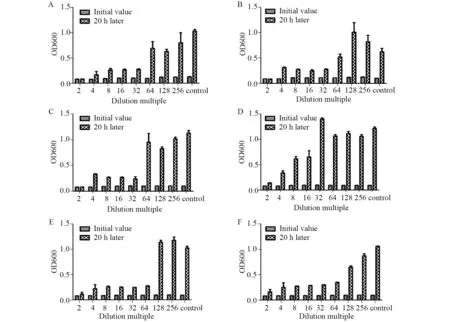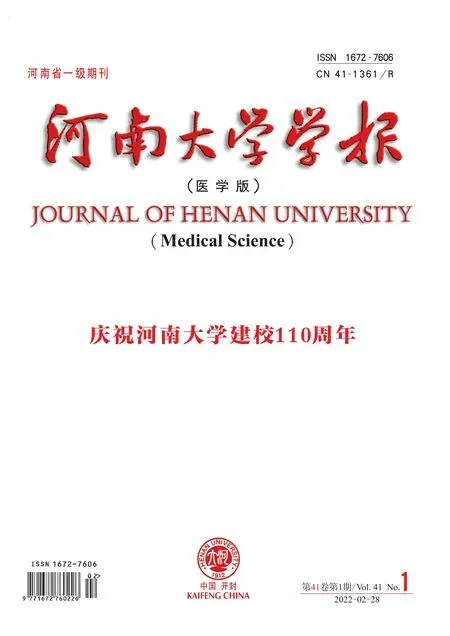水包油型茶树油纳米乳的制备及其体外抑菌活性研究
王昭人韩露露牛月月庞冰党淑敏安磊
河南大学 医学院,河南 开封475000
0 Introduction
Tea tree oil(TTO),a kind of pure natural plant essential oil extracted from the Melaleuca Alternifolia of Myrsuaceae,is also called Melaleuca Alternifolia oil in botany.4-terpinenol and 1,8-cineole are the main components in multicomponent TTO[1].Melaleuca alternifolia is mainly produced in the southeast coast of Australia,whereas Guangxi Province is the main producing area in China.Previous studies proved that TTO had broad spectrum antibacterial activity and inhibition impact on many bacteria and fungi[2-6].
However,TTO has certain shortcomings that make it not work well.That TTO stored for too long or improperly will cause oxidation of the oil and reduce its quality.In addition,TTO is insoluble in water.Considering the fact that TTO is soluble in water hardly but in organic solvents easily,moreover,nano-emulsions can prolong storage period,increase the solubility,absorptivity and efficacy of TTO and reduce the side effects[8],thus,we made TTO into O/W nano-emulsions to improve the shortcoming above,and in this way,we can study bacteriostatic activity more efficiently.
O/W TTO nano-emulsions are sorts of paleyellow and slightly transparent emulsions,which are not layered after standing and stable in nature[7].The TTO nano-emulsion was demonstrated with Z-Average of 21.78 nm by means of Malvern particle size analyzer.In the present study,different dilution multiple O/W TTO nano-emulsions were obtained by double dilution method.Then we determined the OD values before and after culturing the strains in above nano-emulsions for 20 h to observe the growth of the strains,and studied bacteriostatic activity of O/W TTO nano-emulsions.Our results showed that water-in-oil tea tree oil nano-emulsions had potent antibacterial effects.
1 Materials and methods
1.1 Reagent
Tea tree oil(Jiangxi Cedar Natural Medicinal Oil Co.,Ltd.),GMCY,CO40,Anhydrous alcohol,Double distilled water,Yeast extract,Tryptone,Sodium hydroxide,Sodium Chloride.
1.2 Instruments
Constant temperature oscillator (SHZ82,Guohua Enterprise),Biochemical incubator(Blue Pard,Shanghai Yiheng Scientific Instruments Co.,Ltd.),Enzyme-labeled instrument(Spectra Max i3x,Molecylar Devices),96-well plate (96Well Costar blk/clrbtm),Ultraviolet spectrophotometer(D30,Eppendorf),Malvern particle size analyzer,High-pressure steam sterilizer,Mechanical stirrer,Biosafety cabinet,p H Meter,Micropipette,Shaking tube.
1.3 Strains
Escherichia coli,Candida albicans,Staphylococcus aureus,Pseudomonas aeruginosa,Acinetobacter Baumannii,Klebsiella pneumonia were provided by the Laboratory Department of Huaihe Hospital,Henan University.
1.4 Methods
Preparation of O/W TTO nano-emulsions 60 g CO40 and 20 g tea tree oil crude oil were added to beaker and stirred at low and uniform speed with mechanical stirrer until the mixture had been uniform.20 g GMCY and 10 g anhydrous ethanol mixed solution was slowly poured into the beaker,then 90 g double distilled water was added slowly.Thereafter,stirred them constantly to obtain O/W TTO nano-emulsions with 10% mass fraction.
1.5 Quality evaluation of O/W TTO nano-emulsions
The prepared O/W TTO nano-emulsions were put into the conditions of-20 ℃,4 ℃and 60 ℃for 20 h to observe their appearances.The experimental group was repeated three times.The results showed that the O/W TTO nano-emulsions were frozen at-20 ℃,recovered to be clear and transparent after melting,and remained clear and transparent at 4 ℃and 60 ℃.The prepared O/W TTO nano-emulsions were added to water and repeated three times.The results showed that the mixed solution was clear and transparent without suspended substance.
1.6 Preparation of LB liquid medium
10 g tryptone,5 g yeast extract,and 10 g NaCl were added to 950mL double distilled water,shook the container until the solutes had dissolved.p H was adjusted to 7.0 with 5 mol/L NaOH,the volume was adjusted to 1 L with double distilled water,the medium was sterilized by steam at 121℃,103.42 k Pa high pressure for 21 minutes and stored at 4 ℃after cooling.
1.7 Preparation of bacteria
The biosafety cabinet was exposed to ultraviolet lamp for 30 minutes,ventilated for 15 minutes.5mL LB liquid medium and the bacteria were added to the shaking tube.The tube was oscillated overnight in constant temperature oscillator when they were completely dissolved.
1.8 Dilution of TTO
10% O/W TTO mother liquor was diluted by double-dilution method for 7 times continuously with LB liquid medium,then the concentration of the solution finally formed was respectively 20,2-1,2-2,2-3,2-4,2-5,2-6,2-7of the mother liquor.
1.9 Determination of OD 600
OD 600 values of the bacteria were measured by ultraviolet spectrophotometer,afterwards,the bacterial solution was diluted until OD 600 value had been 0.1.The diluted bacterial solution was added to 96-well plate,8 experimental groups and 1 blank control group were set up for each kind of bacteria,3 compound holes were set up for each dilution.After 50μL bacteria were added to each hole of experimental groups,50μL different dilution multiple TTO nano-emulsions were added in turn.50μL LB liquid medium were added to the blank control groups and outer holes,then the initial OD 600 values of bacteria were measured in enzyme-labeled instrument.After the 96-well plate was cultured at 37 ℃in biochemical incubator for 20 h,the OD 600 values of bacteria were measured again.
2 Results
2.1 Size distribution by intensity of TTO nanoemulsions
The maximum concentration of TTO nanoemulsions is 10% (mass fraction),in the present study we determined the effects of different dilution multiples O/W TTO nano-emulsions on the experimental bacteria.
Fig.1 represented size distribution of TTO nano-emulsions.The density was the strongest near 20 nm.Z-Average of TTO nano-emulsions was 21.78 nm.

Fig.1 Size distribution by intensity of TTO nano-emulsions
2.2 OD 600 of six experimental bacteria
Tab.1 and Fig.2 represented OD values.The initial values of dilution group and control group were almost the same,but the values of 20 h later of them were quite different.

Tab.1 OD 600 values of six experimental bacteria
Fig.2A showed the bacteriostatic effect on different dilution multiple O/W TTO nano-emulsions againstE.coli.20 h later,the OD values of dilution group were all lower than that of control group,and the OD values after 20 h were slightly higher than the initial values when diluted 2 to 32 times,while significantly increased when diluted 64 to 256 times.It represented that O/W TTO nano-emulsions with different dilutions can inhibit the growth ofE.coli,and the inhibition is strong when the dilution multiple is between 2 to 32 times,while relatively weak when between 64 to 128 times
Fig.2B showed the bacteriostatic effect on different dilution multiple O/W TTO nano-emulsions againstC.albicans,20 h later,the OD values of dilution group were lower than that of control group when diluted 2 to 64 times,but higher when diluted 128 and 256 times.It represented that O/W TTO nano-emulsions can inhibit the growth ofC.albicanswhen diluted 2 to 64 times,but promote when dilution multiple is larger.
Fig.2C teriostatic effect on different dilution multiple O/W TTO nano-emulsions againstS.au-reus,similarly to Fig.2A,20 h later,the OD values of dilution group were all lower than that of control group,and the OD values after 20 h were slightly higher than the initial values when diluted 2 to 32 times,while significantly increased when diluted 64 to 256 times.It represented that O/W TTO nano-emulsions with different dilutions can inhibit the growth ofS.aureus,and the inhibition is strong when the dilution multiple was between 2 to 32 times,while relatively weak when between 64 to 128 times.
Fig.2D showed the bacteriostatic effect on different dilution multiple O/W TTO nano-emulsions againstP.aeruginosa,20 h later,the OD values of dilution group were lower than that of control group when diluted between 2 to 16 times,and the OD values after 20 h were gradually increased.Moreover,the OD values of dilution group was higherthan that of control group when diluted 32 times,and were a little lower when diluted 64 to 256 times.It represented that O/W TTO nano-emulsions with different dilutions had different effect on the growth ofP.aeruginosa.It inhibited the growth ofP.aeruginosawhen diluted 2 to 16 times,and the lower the dilution multiples,the stronger the inhibition.Moreover,it can inhibit the growth ofP.aeruginosawhen diluted 32 times,and has almost no effect when diluted more than 32 times.

Fig.2 OD 600 histogram of six experimental bacteria
Fig.2E showed the bacteriostatic effect on different dilution multiple O/W TTO nano-emulsions againstA.baumannii,we can see 20 h later,the OD values of dilution group were much lower than that of control group when diluted 2 to 64 times,but higher when diluted 128 and 256 times.It represented that O/W TTO nano-emulsions strongly inhibited the growth ofA.baumanniiwhen diluted 2 to 64 times,but promote when dilution multiple was larger.
Fig.2F showed the bacteriostatic effect on different dilution multiple O/W TTO nano-emulsions againstK.pneumonia,we can see 20 h later,the OD values of dilution group were all lower than that of control group,and the larger the dilution multiple,the higher the OD value.It represented that O/W TTO nano-emulsions with different dilutions can inhibit the growth ofK.pneumonia,and the larger the dilution multiple,the weaker the inhibitory effect.
2.3 MIC values of six experimental bacteria
Fig.3 represented MIC values.The MIC values ofE.coli,S.aureusandK.pneumoniawere 2-8×10%,that ofC.albicansandA.baumanniiwere 2-6×10%,and ofP.aeruginosawas 2-4×10%.

Fig.3 MIC values of six experimental bacteria
3 Discussion
The results showed that TTO nano-emulsions had the strongest inhibitory effect onE.coli,S.aureusandK.pneumoniae,their MIC values all were 2-8×10%.Among them,the inhibitory effects onE.coliandS.aureuswere not very significant at low concentration of 2-6×10%~2-8×10%,but remarkable at high concentration of 2-1×10%~2-5×10%.The inhibitory effect onK.pneumoniaeenhanced with the increase of the concentration of TTO nano-emulsions.TTO nanoemulsions had relatively strong inhibitory effect onC.albicansandA.baumannii,their MIC values both were 2-6×10%.It showed a growth-promoting effect onC.albicansandA.baumanniiat low concentrations of 2-7×10%and 2-8×10%.ForC.albicans,the inhibition was not very remarkable at medium concentration of 2-6×10%,notable at high concentration of 2-2×10%~2-5×10%,and had certain bactericidal effect at very high concentration of 2-1×10%.Besides,the inhibition of TTO nano-emulsions onP.aeruginosawas weak,the MIC value ofP.aeruginosawas 2-4×10%.At the concentration of 2-5×10%,TTO showed a facilitating effect onP.aeruginosa,the inhibition was very weak at low concentration of 2-6×10%~2-8×10%.At high concentration of 2-2×10%~2-4×10%,the inhibition increased with the increase of concentration of TTO nano-emulsions.Only at very high concentration of 2-1×10%did it show strong bacteriostasis.
Our results demonstrated O/W TTO nano-emulsions had strong bacteriostasis.Among the six experimental strains,TTO had the strongest inhibitory effect onE.coli,S.aureusandK.pneumoniae,relatively strong inhibitory effect onC.albicansandA.baumannii,the weakest inhibitory effect onP.aeruginosa.
Our results showed thatP.aeruginosadisplayed low sensitivity to TTO,it had extremely strong inhibitory only under extremely high concentration.This might be involved in the“intrinsic resistance”ofP.aeruginosa,which was coincident with previous study[9].
The common method for solving TTO insoluble in water is adding Tween 80 to TTO as cosolvent,while previous studies showed that the bacteriostatic effect would be limited by Tween 80[10].Therefore,it is crucial to elucidate the function of O/W TTO nano-emulsions,our analysis revealed that TTO nano-emulsions solved the problem of water insolubility,meanwhile,exerted their bacteriostatic effectively.
Antibiotics are commonly used in clinic as bacteriostatic or antibacterial drugs,but with the wide use of antibiotics,multidrug resistant bacteria and antibiotic resistance genes are emerging and spreading[11].In contrast,TTO has extensive sources,broad-spectrum antimicrobials,environmental protection non-pollution,non-corrosive and strong permeability.Moreover,O/W TTO nanoemulsions have higher absorption rate and solubility,along with high utilization value[8].Results of our investigation indicated that O/W TTO nanoemulsions had good bacteriostasis,which provided some ideas for the research of the application aspects of it.O/W TTO nano-emulsions are hopeful to be an alternative to antibiotics,and have extensive application prospect.
4 Conclusion
Our results revealed that O/W TTO nanoemulsions had good bacteriostatic effect in vitro on many common gram-positive bacteria,gram-negative bacteria and fungi,which further verified the broad-spectrum antibacterial activity of TTO.Additional experiments will be needed to further elucidate the bacteriostasis in vivo and the inhibition of some special bacteria.

